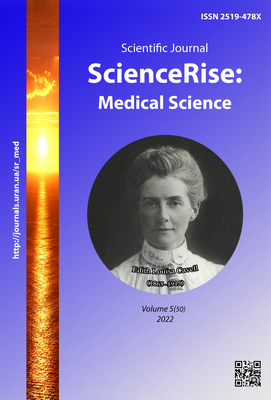Diagnostic approach to chronic bowel diseases in children
DOI:
https://doi.org/10.15587/2519-4798.2022.265388Keywords:
calprotectin, ulcerative colitis, non-ulcerative colitis, rritable bowel syndrome, diagnostics, childrenAbstract
Diagnosing inflammatory bowel diseases in children and differentiating them from functional disorders is complicated based on clinical assessment, laboratory data, and radiological, endoscopic, and histological signs. Therefore, in paediatrics, substantial attention has been given to standard invasive evaluation methods. Recently, research efforts have been directed towards using faecal calprotectin as a sensitive non-invasive stool test.
The aim of the research was to study the diagnostic value of faecal calprotectin in pediatric chronic inflammatory bowel diseases. The paper discusses faecal calprotectin's diagnostic and monitoring role in 35 children aged 3 to 17 years with ulcerative colitis, non-specific non-ulcerative colitis, and irritable bowel syndrome. The concentration of the faecal calprotectin level was examined by ELISA using monoclonal antibodies.
Results. The study shows that in patients with non-specific ulcerative and non-ulcerative colitis, the faecal calprotectin level exceeds the normal ranges 2-5 times, corresponding to clinical and morphological manifestations of the diseases and the level of inflammatory markers. However, this biological marker does not exceed the average values in children with irritable bowel syndrome.
Conclusions. The faecal calprotectin test allows us to differentiate organic and functional intestinal diseases, monitor chronic inflammatory bowel disease activity dynamics, and estimate treatment effectiveness. Applying the faecal calprotectin test within the framework of primary medical care can decrease the number of referrals for invasive endoscopic, laboratory, and radiologic examinations in pediatric patients with inflammatory bowel diseases
References
- Tontini, G. E., Vecchi, M., Pastorelli, L., Neurath, M. F., Neumann, H. (2015). Differential diagnosis in inflammatory bowel disease colitis: state of the art and future perspectives. World Journal of Gastroenterology, 21 (1), 21–46. doi: https://doi.org/10.3748/wjg.v21.i1.21
- Misra, R., Faiz, O., Munkholm, P., Burisch, J., Arebi, N. (2018). Epidemiology of inflammatory bowel disease in racial and ethnic migrant groups. World Journal of Gastroenterology, 24 (3), 424–437. doi: https://doi.org/10.3748/wjg.v24.i3.424
- Stepanov, Yu. M., Skyrda, I. Yu., Petishko, O. P. (2017). Chronic inflammatory bowel diseases: epidemiological features in Ukraine. Gastroenterology, 51 (2), 97–105. doi: https://doi.org/10.22141/2308-2097.51.2.2017.101703
- Denisova, M. F., Muzyka, N. M., Cherneha, N. V., Zadorozhna, T. D., Archakova, T. M., Bukulova, N. Yu. (2017). Peculiarities of the course of ulcerative colitis in children at the present stage. Child’s Health, 12 (2), 136–141. doi: https://doi.org/10.22141/2224-0551.12.2.2017.99769
- Belousova, O. Yu. (2013). Chronic non-specific nonulcer colitis in children. Perinatologija i pediatrija, 1, 87–91. Available at: http://nbuv.gov.ua/UJRN/perynatology_2013_1_19
- Campbell, J. P., Zierold, C., Rode, A. M., Blocki, F. A., Vaughn, B. P. (2020). Clinical Performance of a Novel LIAISON Fecal Calprotectin Assay for Differentiation of Inflammatory Bowel Disease From Irritable Bowel Syndrome. Journal of Clinical Gastroenterology, 55 (3), 239–243. doi: https://doi.org/10.1097/mcg.0000000000001359
- Kawashima, K., Ishihara, S., Yuki, T., Fukuba, N., Oshima, N., Kazumori, H. et. al. (2016). Fecal calprotectin level correlated with both endoscopic severity and disease extent in ulcerative colitis. BMC Gastroenterology, 16 (1), 47–54. doi: https://doi.org/10.1186/s12876-016-0462-z
- Laserna-Mendieta, E. J., Lucendo, A. J. (2019). Faecal calprotectin in inflammatory bowel diseases: a review focused on meta-analyses and routine usage limitations. Clinical Chemistry and Laboratory Medicine (CCLM), 57 (9), 1295–1307. doi: https://doi.org/10.1515/cclm-2018-1063
- Haisma, S.-M., Verkade, H. J., Scheenstra, R., van der Doef, H. P. J., Bodewes, F. A. J. A., van Rheenen, P. F. (2019). Time-to-reach Target Calprotectin Level in Newly Diagnosed Patients With Inflammatory Bowel Disease. Journal of Pediatric Gastroenterology & Nutrition, 69 (4), 466–473. doi: https://doi.org/10.1097/mpg.0000000000002458
- Fagerhol, M. K., Dale, I., Anderson, T. (2009). Release and Quantitation of a Leucocyte Derived Protein (L1). Scandinavian Journal of Haematology, 24 (5), 393–398. doi: http://doi.org/10.1111/j.1600-0609.1980.tb02754.x
- Khaki-Khatibi, F., Qujeq, D., Kashifard, M., Moein, S., Maniati, M., Vaghari-Tabari, M. (2020). Calprotectin in inflammatory bowel disease. Clinica Chimica Acta, 510, 556–565. doi: https://doi.org/10.1016/j.cca.2020.08.025
- Golovanova I. A., Bjelikova I. V., Ljahova N. O. (2017). The basics of medical statistics: a textbook for graduate students and clinical residents. Poltava, 113.
Downloads
Published
How to Cite
Issue
Section
License
Copyright (c) 2022 Tetiana Yaroshevska, Kateryna Skriabina

This work is licensed under a Creative Commons Attribution 4.0 International License.
Our journal abides by the Creative Commons CC BY copyright rights and permissions for open access journals.
Authors, who are published in this journal, agree to the following conditions:
1. The authors reserve the right to authorship of the work and pass the first publication right of this work to the journal under the terms of a Creative Commons CC BY, which allows others to freely distribute the published research with the obligatory reference to the authors of the original work and the first publication of the work in this journal.
2. The authors have the right to conclude separate supplement agreements that relate to non-exclusive work distribution in the form in which it has been published by the journal (for example, to upload the work to the online storage of the journal or publish it as part of a monograph), provided that the reference to the first publication of the work in this journal is included.









